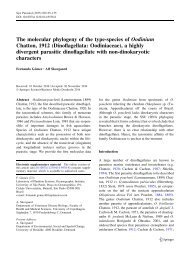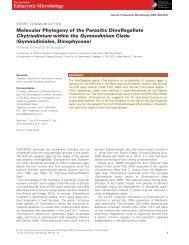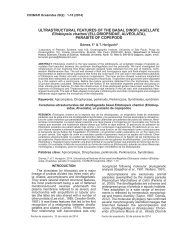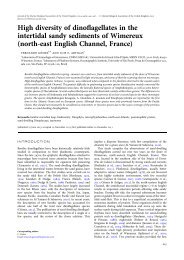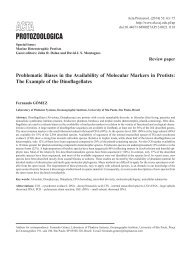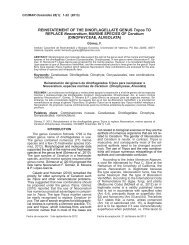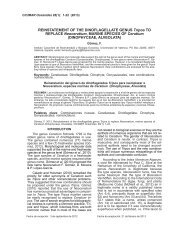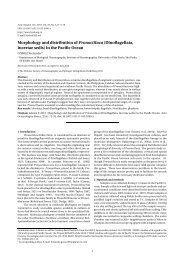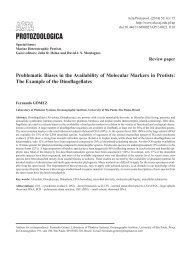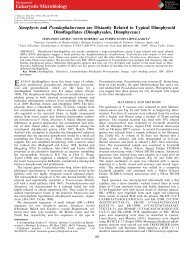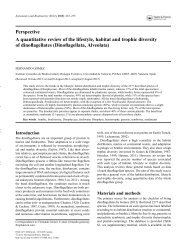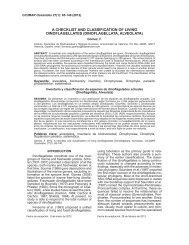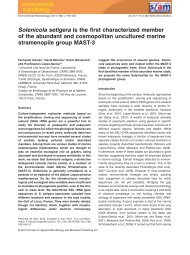The formation of the twin resting cysts in the dinoflagellate Dissodinium pseudolunula, a parasite of copepod eggs
The dinoflagellate Dissodinium pseudolunula is the most common and widespread ectoparasite of copepod eggs in neritic waters. When the host is absent, the species survives with a distinctive pair of twin resting cysts described as Pyrocystis margalefii. Based on live samples, the formation of the twin resting cysts is illustrated here for the first time. The gymnodinioid infective cells did not form overwintering cysts under unfavourable conditions. These are formed inside the secondary lunate sporangium
The dinoflagellate Dissodinium pseudolunula is the most common and widespread ectoparasite
of copepod eggs in neritic waters. When the host is absent, the species survives
with a distinctive pair of twin resting cysts described as Pyrocystis margalefii. Based
on live samples, the formation of the twin resting cysts is illustrated here for the first
time. The gymnodinioid infective cells did not form overwintering cysts under
unfavourable conditions. These are formed inside the secondary lunate sporangium
Create successful ePaper yourself
Turn your PDF publications into a flip-book with our unique Google optimized e-Paper software.
JOURNAL OF PLANKTON RESEARCH j VOLUME 35 j NUMBER 5 j PAGES 1167–1171 j 2013<br />
(Fig. 2K–R). In sand samples, a s<strong>in</strong>gle <strong>rest<strong>in</strong>g</strong> cyst was<br />
also found on 17 September 2010 (Fig. 2R).<br />
Several lunate sporangia and <strong>tw<strong>in</strong></strong> <strong>rest<strong>in</strong>g</strong> <strong>cysts</strong> were<br />
observed on 8 July 2010. As a general trend, each recently<br />
released lunate sporangium conta<strong>in</strong>ed a hyal<strong>in</strong>e mass<br />
and a prom<strong>in</strong>ent nucleus. This content transformed by<br />
b<strong>in</strong>ary fission <strong>in</strong>to eight gymnod<strong>in</strong>ioid cells that acquired<br />
a green-brownish pigmentation (Fig. 1, see Supplementary<br />
data, Video, http://www.youtube.com/watch?v=Y-<br />
GA6U3EhdU). However, some lunate sporangia showed<br />
an <strong>in</strong>tense pigmentation before <strong>the</strong> <strong>formation</strong> <strong>of</strong> <strong>the</strong> first<br />
pair <strong>of</strong> daughter cells (Fig. 2E). One <strong>of</strong> <strong>the</strong>se lunate sporangia<br />
conta<strong>in</strong>ed a pair <strong>of</strong> <strong>the</strong> <strong>tw<strong>in</strong></strong> <strong>rest<strong>in</strong>g</strong> <strong>cysts</strong>. <strong>The</strong>y lacked<br />
<strong>the</strong> dist<strong>in</strong>ctive orange granules that characterized <strong>the</strong><br />
typical <strong>tw<strong>in</strong></strong> <strong>rest<strong>in</strong>g</strong> <strong>cysts</strong> (Fig. 2F–J). This is <strong>the</strong> first direct<br />
evidence that <strong>the</strong> <strong>tw<strong>in</strong></strong> <strong>rest<strong>in</strong>g</strong> <strong>cysts</strong> are formed <strong>in</strong>side a<br />
lunate secondary sporangium <strong>of</strong> Dissod<strong>in</strong>ium. In addition, a<br />
pair <strong>of</strong> cells <strong>in</strong>side an outer hyal<strong>in</strong>e membrane was<br />
observed <strong>in</strong> a sand sample collected on 17 May 2010<br />
(Fig. 2S–T). <strong>The</strong> gra<strong>in</strong>y appearance <strong>of</strong> <strong>the</strong> cell contents<br />
and <strong>the</strong> presence <strong>of</strong> an orange granule strongly resembled<br />
a cell that germ<strong>in</strong>ated from a <strong>tw<strong>in</strong></strong> <strong>rest<strong>in</strong>g</strong> cyst.<br />
Based on cultures, Drebes (Drebes, 1978) observed<br />
that <strong>the</strong> <strong>in</strong>fective d<strong>in</strong>ospores formed an outer hyal<strong>in</strong>e<br />
membrane, and <strong>the</strong>y eventually divided <strong>in</strong>side. This has<br />
been also observed <strong>in</strong> natural samples (Fig. 1AH). In<br />
<strong>parasite</strong>s, as a general trend, it is considered that <strong>the</strong> <strong>in</strong>fective<br />
d<strong>in</strong>ospores form <strong>the</strong> <strong>rest<strong>in</strong>g</strong> <strong>cysts</strong> when <strong>the</strong>y are<br />
unable to f<strong>in</strong>d a host (Drebes, 1984). However, <strong>the</strong> <strong>tw<strong>in</strong></strong><br />
<strong>rest<strong>in</strong>g</strong> <strong>cysts</strong> <strong>of</strong> D. <strong>pseudolunula</strong> differed from <strong>the</strong> <strong>in</strong>fective<br />
d<strong>in</strong>ospore <strong>in</strong> size, shape and cell content. It is difficult to<br />
accept that <strong>the</strong> latter should be able to form <strong>tw<strong>in</strong></strong> <strong>rest<strong>in</strong>g</strong><br />
<strong>cysts</strong> with a biomass five to eight times greater than <strong>the</strong> <strong>in</strong>fective<br />
d<strong>in</strong>ospore itself. In addition, <strong>the</strong> exhausted <strong>in</strong>fective<br />
d<strong>in</strong>ospore has to accumulate <strong>the</strong> energetic reserves to<br />
survive <strong>the</strong> autumn–w<strong>in</strong>ter period, and to form <strong>the</strong> cellular<br />
functions <strong>of</strong> a new <strong>in</strong>fective d<strong>in</strong>ospore for <strong>the</strong> next spr<strong>in</strong>g.<br />
Drebes (Drebes, 1981) hypo<strong>the</strong>sized that <strong>the</strong> primary sporangium<br />
develops a certa<strong>in</strong> number <strong>of</strong> <strong>rest<strong>in</strong>g</strong> <strong>cysts</strong> <strong>in</strong>stead <strong>of</strong><br />
secondary lunate sporangia, as a possible reaction to chang<strong>in</strong>g<br />
environmental conditions. This study has revealed that<br />
<strong>the</strong> <strong>tw<strong>in</strong></strong> <strong>rest<strong>in</strong>g</strong> <strong>cysts</strong> are formed <strong>in</strong>side <strong>the</strong> secondary lunate<br />
sporangium (Fig. 2F–J). <strong>The</strong> pair <strong>of</strong> <strong>tw<strong>in</strong></strong> <strong>rest<strong>in</strong>g</strong> <strong>cysts</strong><br />
receives 1/8 <strong>of</strong> <strong>the</strong> lipid reserves <strong>of</strong> <strong>the</strong> <strong>in</strong>fected <strong>copepod</strong><br />
Fig. 3. Life cycle <strong>of</strong> Dissod<strong>in</strong>ium <strong>pseudolunula</strong>.<br />
1170



